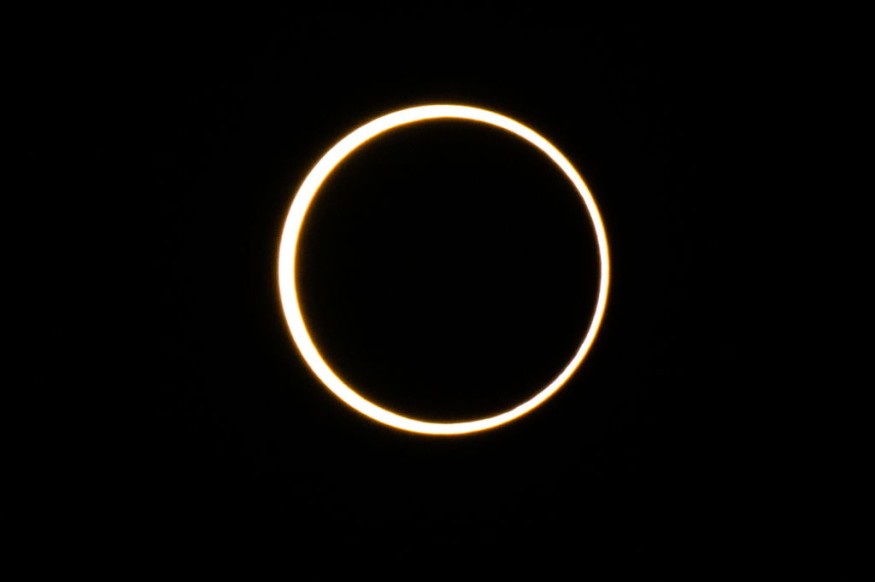On October 14, 2023, North, Central, and South America witnessed a rare annular solar eclipse, with nine lucky states experiencing the mesmerizing "ring of fire" effect as the moon partially covered the sun. This celestial spectacle commenced in the early hours of that Saturday.
To commemorate the event, observers shared photos taken at eclipse viewing parties across the Americas. Many of them stood out, showcasing the moon's shadow and sunspots on the solar surface, which reminds of the natural wonders present in the skies.

Stunning Photos of the Annular Solar Eclipse
The recent partial solar eclipse offered a celestial spectacle visible throughout the Americas. However, the remarkable path of annularity, where the moon appeared to pass directly across the sun's center, was exclusively observed in a diagonal trajectory stretching from the northwestern United States down through Central and South America.
In San Salvador, El Salvador, an eclipse enthusiast ingeniously held up his phone to a telescope to document the moon's slow transit towards the sun's center. Meanwhile, in Mexico City, photographer Gerardo Vieyra seized the opportunity to capture the moon's gradual passage by the Angel of Independence statue.
The darkened sky in his photograph was an artistic effect that allowed us to peer through the clouds. It's worth noting that the entire eclipse occurred during daylight, and it never reached the point of "totality" where the sun would be entirely concealed by the moon.
Photographer Brandon Bell, stationed in Kerrville, Texas, captured a mesmerizing image as the "ring of fire" began to emerge around the moon's shadow, signifying the arrival of the annular phase.
Rare ‘Ring of Fire’ eclipse happened today...
— Joni Job (@jj_talking) October 14, 2023
The eclipse visible through Southern Oregon, Nevada, Utah, New Mexico, and Southwest Texas in US
The annular solar eclipse started at 9:13 a.m. PDT (12:13 ET) in the United States pic.twitter.com/tOtonzA4Et
As the pivotal moment of annularity neared, a radiant "ring of fire" enveloped the moon's shadow, providing a stunning visual from Albuquerque, New Mexico, as skillfully captured by Sam Wasson.
A perfect necklace and ring of fire captured today during the Annular Solar Eclipse 2023 from New Mexico!#greatamericansolareclipse #nmwx pic.twitter.com/rWKQDUajTs
— Saurabh Patil (@saurabh_wx) October 14, 2023
The Central America and South America also enjoyed a captivating view of the eclipse, as demonstrated in a photograph taken by Diego Cuevas outside a planetarium in Bogota, Colombia, where eclipse enthusiasts gathered for a viewing party.
Closer to the ground, the eclipse cast crescent-shaped shadows, creating a natural pinhole projection effect that fascinated onlookers, particularly children who gazed upwards through their eclipse glasses. This celestial event served as a testament to the wonders of the natural world that continue to awe and inspire.
READ ALSO : What To Expect During a Solar Eclipse? 10 Unusual Phenomena to Look Out for This Weekend
When Is the Next Annular Solar Eclipse?
In the upcoming years, a series of captivating solar eclipses is set to grace the skies, each offering a unique celestial spectacle. In 2023, a rare annular solar eclipse took center stage on October 14, visible across regions spanning from West Africa to the Arctic. Lucky observers witnessed the awe-inspiring "ring of fire" effect as the moon partially obscured the sun, leaving only its blazing outline.
The year 2024 promises another noteworthy eclipse on October 2, with the annular solar phenomenon visible in the southern parts of North and South America, the Pacific, the Atlantic, and even Antarctica.
These celestial events in 2023 and 2024 are just a glimpse of the wonder and beauty our universe has in store, offering a unique opportunity for skywatchers and astronomers to be captivated by the marvels of our solar system.
The years 2026 through 2032 will bring a succession of annular solar eclipses, captivating viewers across regions ranging from Africa and South America to Europe, Asia, Australia, and even Antarctica. These celestial events remind us of the ever-entrancing dance of the sun, moon, and Earth, offering moments of celestial magic for people around the world to enjoy.
RELATED ARTICLE : From 'Ring of Fire' to Total Solar Eclipse: What To Expect From the Upcoming Celestial Meeting Next Year
Check out more news and information on Solar Eclipse in Science Times.












